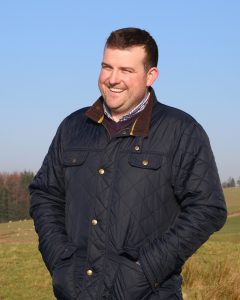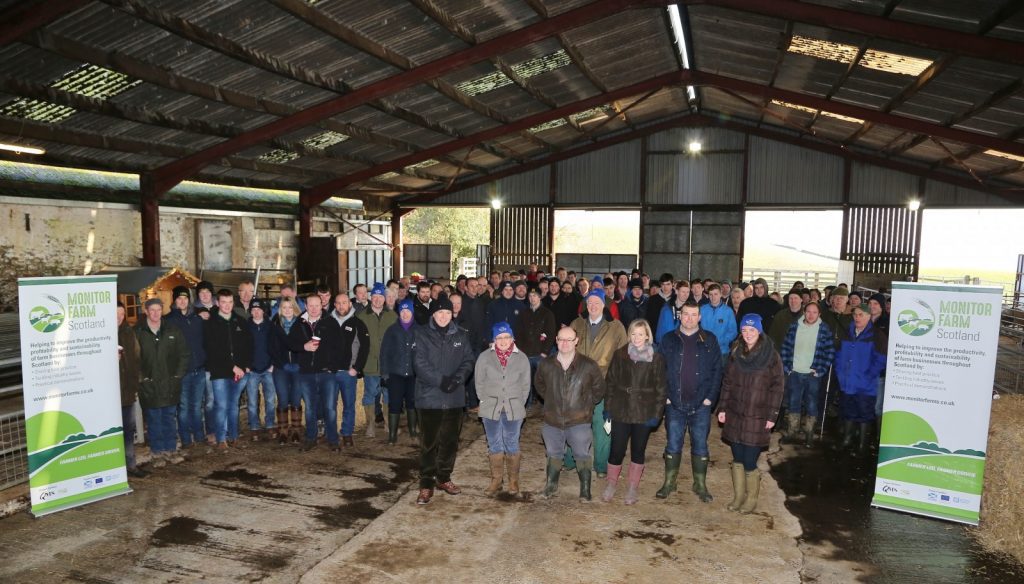A huge turnout of around 100 people were welcomed to the lively first meeting of the new Nithsdale monitor farm.

Beef and sheep farmers Andrew and Aileen Marchant of Clonhie, Penpont, near Thornhill will be opening their gates regularly during the three years of the programme as one of nine monitor farms which have been set-up in Scotland.
The initiative, being run jointly by Quality Meat Scotland (QMS) and AHDB Cereals & Oilseeds, aims to help improve the productivity, profitability and sustainability of Scottish farm businesses.
The Marchants run 900 ewes and a small herd of 12 Luing cattle on their 300 hectares (750 acres) which lies between 450 and 950 feet above sea level.
Andrew Marchant sees huge potential benefit from getting involved in the project, both for his business and for the other farmers who get involved and share the benefits.
“One area we’re sure we could do better is our grazing management. We reckon with careful management our grass could increase our cow numbers to about 35 and, by introducing rotational grazing, we could significantly increase our flock size,” said Mr Marchant.
Among the speakers at the first meeting was independent sheep specialist Dr John Vipond who said the new monitor farm project, funded by the Scottish Government, had started at a crucial time for farmers.
“The clock is ticking. I reckon you have about two to three years to really look closely at your efficiency, bring your costs down and get your house in order,” Dr Vipond told farmers attending.
“The six most expensive words in farming are ‘we’ve always done it that way’. This project will give you a great chance to see the results of introducing changes which will give you the confidence to do the same,” he added.
One example where he said there was serious scope for improvement was worming regimes. “You wouldn’t treat a field for thistles without checking first that there are thistles there and yet hardly any of you are doing faecal egg counts before you worm your sheep,” Dr Vipond observed.
Former Forth monitor farmer Duncan McEwen gave an inspirational insight into how his Arnprior business had benefitted from being involved in the project.
“For us it was a fantastic opportunity which really gives you the confidence to make changes based on hard facts and figures. Our whole farm review revealed our fixed costs were killing us and there was significant scope for us to increase our output per hectare to help spread these costs.
“Our business was simply too complex and it made me face up to being an ‘iron addict’ and tackle my obsession with machinery and also our soil compaction problems. We are now in a much stronger position to move forward and cope with reduced farm support,” said Mr McEwen.
One key success story at Arnprior was the introduction of rotational grazing. “The switch to splitting fields into smaller paddocks and moving sheep on when our grass reaches a certain height has been hugely beneficial. We can achieve 25% to 30% more grass, decrease our fertiliser usage and increase our liveweight gain.”
The monitor farm experience also played a part in opening the McEwens’ minds to new opportunities. They now grow 3000 pumpkins offered on a pick-your-own basis to the public at Halloween and offer four days of paid for lambing experience to the public in spring.
They are also looking at the potential of installing some glamping pods on the farm, along with other ambitious diversification ideas.
If you would like to be involved in the Nithsdale monitor farm project you can find out more from facilitator Judith Hutchison on 07718 919055 or email [email protected].
For more information about the monitor farm programme visit www.qmscotland.co.uk or www.cereals.ahdb.org.uk.






